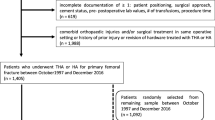Abstract
Purpose
Fractures of the proximal femur in geriatric patients are life-changing and life-threatening events. Previous research has identified fluid volume as an independent factor contributing to trauma patients’ complications. Therefore, we aimed to investigate the impact of intraoperative fluid volume on outcomes in geriatric patients undergoing hip fracture surgery.
Methods
We conducted a retrospective single-center study with data from the hospital information systems. Our study included patients aged 70 years or older who had sustained a proximal femur fracture. We excluded patients with pathologic, periprosthetic, or peri-implant fractures and those with missing data. Based on the fluids given, we divided patients into high-volume and low-volume groups.
Results
Patients with a higher American Society of Anesthesiologists (ASA) grade and more comorbidities were more likely to receive more than 1500 ml of fluids. We observed significant differences in anesthesiologic management between the two groups, with a higher rate of invasive blood pressure management (IBP) and central venous catheter usage in the high-volume group. High-volume therapy was associated with a higher rate of complications (69.7% vs. 43.6%, p < 0.01), a higher transfusion rate (odds ratio 1.91 [1.26–2.91]), and an increased likelihood of patients being transferred to an intensive care unit (17.1% vs. 6.4%, p = 0.009). These findings were confirmed after adjusting for ASA grade, age, sex, type of fracture, Identification-of-Seniors-At-Risk (ISAR) score, and intraoperative blood loss.
Conclusions
Our study suggests that intraoperative fluid volume is a significant factor that impacts the outcome of hip fracture surgery in geriatric patients. High-volume therapy was associated with increased complications.
Similar content being viewed by others
Data availability
Not applicable.
References
Schnell S, Friedman SM, Mendelson DA, et al. The 1-year mortality of patients treated in a hip fracture program for elders. Geriatr Orthop Surg Rehabil. 2010;1:6–14. https://doi.org/10.1177/2151458510378105.
Coburn M, Röhl AB, Knobe M, et al. Anästhesiologisches Management in der Alterstraumatologie (Anesthesiological management of elderly trauma patients). Anaesthesist. 2016;65:98–106. https://doi.org/10.1007/s00101-016-0136-9.
Hahn RG. Volume kinetics for infusion fluids. Anesthesiology. 2010;113:470–81. https://doi.org/10.1097/ALN.0b013e3181dcd88f.
Hussmann B, Heuer M, Lefering R, et al. Prehospital volume therapy as an independent risk factor after trauma. Biomed Res Int. 2015;2015:354367. https://doi.org/10.1155/2015/354367.
Hussmann B, Lefering R, Waydhas C, et al. Does increased prehospital replacement volume lead to a poor clinical course and an increased mortality? A matched-pair analysis of 1896 patients of the Trauma Registry of the German Society for Trauma Surgery who were managed by an emergency doctor at the accident site. Injury. 2013;44:611–7. https://doi.org/10.1016/j.injury.2012.02.004.
Kusen JQ, van der Vet PCR, Wijdicks FJG, et al. Does preoperative hemodynamic preconditioning improve morbidity and mortality after traumatic hip fracture in geriatric patients? A retrospective cohort study. Arch Orthop Trauma Surg. 2021;141:1491–7. https://doi.org/10.1007/s00402-020-03601-5.
Willis J, Pelzl CE, Jarvis S, et al. Significant variations in preoperative fluid resuscitation volumes delivered to elderly hip fracture patients at six level 1 trauma centers: an observational descriptive study. OTA Int. 2022;5:e162. https://doi.org/10.1097/OI9.0000000000000162.
Bartha E, Arfwedson C, Imnell A, et al. Towards individualized perioperative, goal-directed haemodynamic algorithms for patients of advanced age: observations during a randomized controlled trial (NCT01141894). Br J Anaesth. 2016;116:486–92. https://doi.org/10.1093/bja/aew025.
Lorente JV, Reguant F, Arnau A, et al. Effect of goal-directed haemodynamic therapy guided by non-invasive monitoring on perioperative complications in elderly hip fracture patients within an enhanced recovery pathway. Perioper Med (Lond). 2022;11:46. https://doi.org/10.1186/s13741-022-00277-w.
Horvath B, Kloesel B, Todd MM, et al. The evolution, current value, and future of the american society of anesthesiologists physical status classification system. Anesthesiology. 2021;135:904–19. https://doi.org/10.1097/ALN.0000000000003947.
McCusker J, Bellavance F, Cardin S, et al. Detection of older people at increased risk of adverse health outcomes after an emergency visit: the ISAR screening tool. J Am Geriatr Soc. 1999;47:1229–37. https://doi.org/10.1111/j.1532-5415.1999.tb05204.x.
Dindo D, Demartines N, Clavien P-A. Classification of surgical complications: a new proposal with evaluation in a cohort of 6336 patients and results of a survey. Ann Surg. 2004;240:205–13. https://doi.org/10.1097/01.sla.0000133083.54934.ae.
Schoeneberg C, Heuser L, Rascher K, et al. The Geriatrics at Risk Score (GeRi-Score) for mortality prediction in geriatric patients with proximal femur fracture—a development and validation study from the Registry for Geriatric Trauma (ATR-DGU). Osteoporos Int. 2023;34:879–90. https://doi.org/10.1007/s00198-023-06719-5.
Lewis SR, Butler AR, Brammar A, et al. Perioperative fluid volume optimization following proximal femoral fracture. Cochrane Database Syst Rev. 2016;3:CD003004. https://doi.org/10.1002/14651858.CD003004.pub4.
Mosch C Empfehlungen und Erläuterungen der S3-LL Volumentherapie
Moore EE, Moore HB, Kornblith LZ, et al. Trauma-induced coagulopathy. Nat Rev Dis Primers. 2021;7:30. https://doi.org/10.1038/s41572-021-00264-3.
Assaad S, Kratzert WB, Shelley B, et al. Assessment of pulmonary edema: principles and practice. J Cardiothorac Vasc Anesth. 2018;32:901–14. https://doi.org/10.1053/j.jvca.2017.08.028.
Heming N, Moine P, Coscas R, et al. Perioperative fluid management for major elective surgery. Br J Surg. 2020;107:e56–62. https://doi.org/10.1002/bjs.11457.
Shin CH, Long DR, McLean D, et al. Effects of intraoperative fluid management on postoperative outcomes: a hospital registry study. Ann Surg. 2018;267:1084–92. https://doi.org/10.1097/SLA.0000000000002220.
Funding
None.
Author information
Authors and Affiliations
Contributions
BP: Prepared the manuscript, Analyzed the data, Designed the study. DS, FM, BH, TM, RA, CB, DD, SL: Analyzed the data, Reviewed the manuscript. CS: Designed the study, Analyzed the data, Prepared the manuscript. All authors declare that they have read and approved the final manuscript.
Corresponding author
Ethics declarations
Conflict of interest
Bastian Pass, Denis Sieben, Fahd Malek, Bjoern Hussmann, Teresa Maek, Rene Aigner, Christopher Bliemel, Daniel Dirkmann, Sven Lendemans, and Carsten Schoeneberg declare that they have no conflict of interest.
Rights and permissions
Springer Nature or its licensor (e.g. a society or other partner) holds exclusive rights to this article under a publishing agreement with the author(s) or other rightsholder(s); author self-archiving of the accepted manuscript version of this article is solely governed by the terms of such publishing agreement and applicable law.
About this article
Cite this article
Pass, B., Sieben, D., Malek, F. et al. Liberal intraoperative fluid management leads to increased complication rates in geriatric patients with hip fracture. Eur J Trauma Emerg Surg 49, 2485–2493 (2023). https://doi.org/10.1007/s00068-023-02326-5
Received:
Accepted:
Published:
Issue Date:
DOI: https://doi.org/10.1007/s00068-023-02326-5




